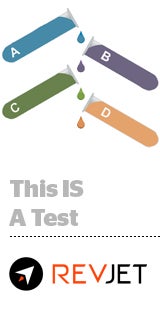 If ad tech is a dinner party, someone forgot to invite the creative – or, at least, that’s what it can often feels like to the marketers and agencies tasked with creative production and testing.
If ad tech is a dinner party, someone forgot to invite the creative – or, at least, that’s what it can often feels like to the marketers and agencies tasked with creative production and testing.
“I’ve been on the agency side and now I’m on the marketing side, and through both of those lenses I’ve seen creative be neglected,” said Diana Choksey, a Razorfish vet and the media technology and ad ops lead at Microsoft.
It’s a neglect that has its roots in tech. “The systems we’re using to disseminate ads in the digital world create boundaries between creative, media and ad serving,” said Choksey, noting the laborious, largely manual process of reporting and real-time campaign optimization.
Roughly eight weeks ago, Microsoft started working with RevJet, a marketing tech company that came out of stealth mode on Thursday with a solution that aims to unify ad creation, serving, testing, measuring and optimization into a single platform for desktop and mobile display, video and social.
Taking a cue from the parlance of ad tech, RevJet is calling its solution a CSP, or creative-side platform, but company CEO and founder Mitchell Weisman is looking to scoop creative out from under ad tech’s umbrella so that it’s not conflated with media. Although the two work in tandem, they do need to be treated differently, he said.
“Media space is just an empty box,” Weisman said. “That’s not where the real value is.”
RevJet integrates directly with whatever demand-side platforms its clients are using. In Microsoft’s case, that was Rocket Fuel. At the moment, RevJet is also integrated with RadiumOne.
Microsoft has been running a number of digital campaigns through RevJet, one of which was an effort geared toward encouraging college students to download Office 365.
To start, Scorch, Microsoft’s creative agency, developed a series of display ads featuring photographs of smiling, productive-looking young people in collegiate settings. Microsoft tested the concept in RevJet, running multiple iterations of the ads against each other simultaneously. When it became clear which piece of creative was outperforming the others in terms of clicks and conversions, the “loser” ad was automatically halted, while the “winner” continued to be served.
From there, a series of multivariate tests were carried out on the imagery, the tagline, the call to action and the click density using RevJet’s heat map feature, homing in test by test on the highest-performing ad of the bunch.
What was particularly interesting to Choksey is that the ultimate winner wasn’t one she and Scorch initially expected. The ad with the highest engagement turned out to be a static piece of creative with a single color in the background and a simple call to action.
 Having figured that out while the campaign was still going on, Microsoft was able to double down on the ad creative that was doing best and jettison the ads that weren’t performing as well. Microsoft saw an average of 123% higher conversions per thousand impressions on the media it ran through RevJet.
Having figured that out while the campaign was still going on, Microsoft was able to double down on the ad creative that was doing best and jettison the ads that weren’t performing as well. Microsoft saw an average of 123% higher conversions per thousand impressions on the media it ran through RevJet.
“We’re looking to make creative into a revenue center rather than a cost center,” Weisman said.
Which, according to Weisman, is what differentiates RevJet from programmatic creative solutions, which mainly focus on simplifying the production process, and from dynamic creative optimization (DCO) tools, which are geared toward retargeting at scale rather than optimization.
In the DCO case, when Customer A checks out a pair of shoes and Customer B has a gander at a sport coat, the shoe-and-sport-coat-themed display ads that subsequently follow them about the Internet aren’t necessarily the ads most likely to convert. Rather, they’re conceivably relevant ads that could feasibly convert.
“There is a fundamental difference between getting an appropriate ad in front of someone and getting the highest-performing ad in front of them,” Weisman said. “There are dozens if not hundreds of different ways to promote that sport coat, some of which will perform far better than others.”
For its part, Microsoft seems pleased.
“Streamlining the ad production and ad serving with creative optimization empowers us to develop the right creative through testing because there is a constant process of iteration and optimization with no time wasted on back and forth,” Choksey said. “It cuts all these middlemen out of the process.”
RevJet started life as a mobile RTB platform housed within LifeStreet Media, a mobile and Facebook in-app advertising company that Weisman co-founded in 2005. In October 2014, Weisman stepped down as CEO of LifeStreet and spun RevJet off into a separate company with a focus on creative testing and optimization.











